Heterotopia, the soul of ruins in Vincent J. Stoker
That work on ruins is surrounded by a true graphic and intellectual coherence coming at a time when architectural photography is fashionable.
Vincent J. Stoker is a young photographer and the winner of our contest « Photography and its Purpose ». In 2011, he will exhibit his series entitled “Heterotopia” at the Alain Gutharc Gallery, in Paris. What shall probably make all the difference to his artistic career is the quality of his proposal coupled with an incredible energy.
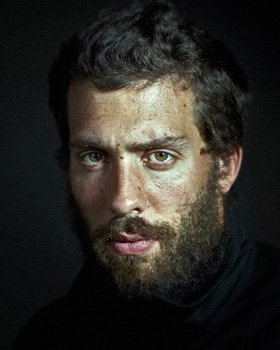
Before Heterotopia, what path led you to photography?
It’s the story of my life, really. I started photographing quite late but always carried a camera around on me. My concerns were initially quite different. I used my camera to memorise details, situations, everything that evoked an idea. Photography has never been an end in itself for me, I started by using it simply as a notebook.
After my studies, I travelled and took a lot of photos without really having a photographic awareness. When I returned to France I felt seriously bored. I discovered, a little by chance, an abandoned derelict industrial site. The Darblay paper factory at Corbeille Essonne. In it I found a kind of exotic setting that reminded me of my travels, a strangeness and a kind of « wonder » : the place plucked me out of the sedate day-to-day boredom that I was subject to at the time. Photographically, was not always great. I was almost hysterical, entranced, I hallucinated totally on everything. I would fire away at the slightest nail, the tiniest screw. I would ponder on doors, windows … everything was worth recording! In short, I emptied batteries to fill memory files. I transformed electric current into pixels. I suffered from a kind of acute photographic bulimia.
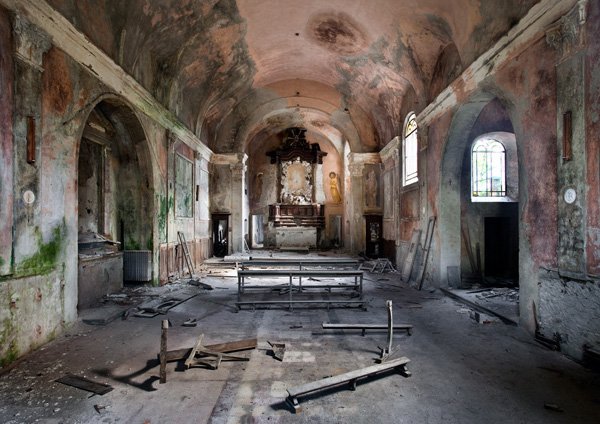
Little by little, analysing my images, I realised that what I wanted to show was a place. The first issue regarding my work came to light: how to show a place in just one photo? There is an economy of the image: one place, one photo; and if possible depicted in all its architectural power. My point of view was, therefore, built gradually (aerial, frontal and synoptic) with the objective of putting on an equal footing all the structure’s levels. I put the camera at the centre of the architecture so as not to favour the ceiling or the floor and consider all parts equitably. At the end, I come to a representation that comes close to that of the concept of the place, the idea of the place, thanks to an almost “divine” point of view.
It took some time for me to crystallise the form and the idea of this point of view, and over time it makes a lot of sense to me. Dominique Gaessler told me that I “cathedralised” the places I photograph. I show them in all their monumentality, when in fact they are in ruins, that paradox seems interesting to me.
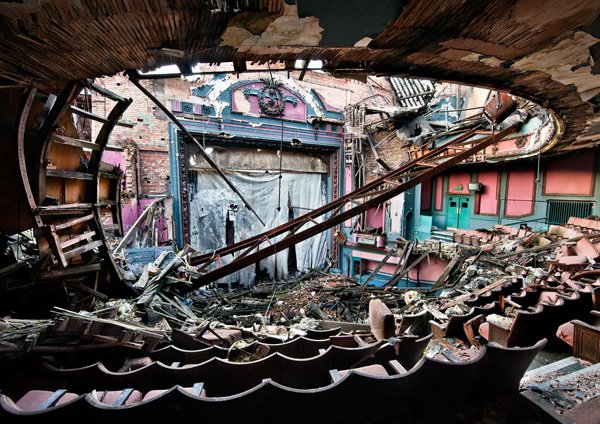
I am influenced by Candida Höfer and her libraries, museums and palaces. In them one finds this systematic point of view. In her work, it underlines the classical harmony of sumptuous places, whereas in my work it creates a meaningful paradox. Her work gives a glorious vision of humanity that seems directed straight to the end of History. My work throws a shadow on that optimistic perspective. I hope I am wrong. The series Heterotopia is an affirmation that must be contradicted.
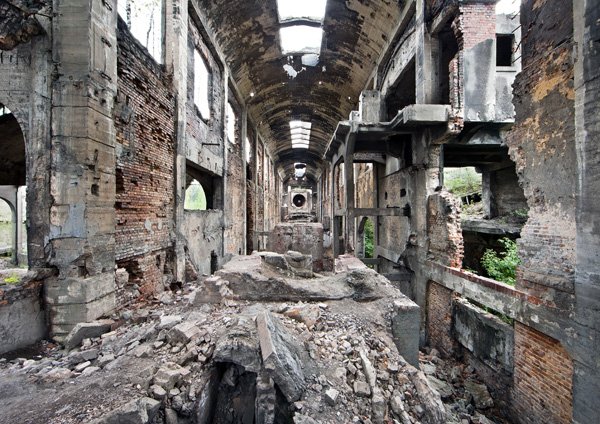
The play of perspectives is very important with this point of view. How do you approach this subject?
Linear perspectives draw the eye of the spectator into the image. If you put these photos on the floor, you have the impression that you could plunge into them. From the top of a skyscraper, we have the same impression of void when we look down. This play of perspectives allows to introduce, as a theme, the movement of the fall, and that is crucial to this work, exactly because these places are fragmenting, loosing their structure. Architects go against the forces of nature to erect these ascending forms. Nature and time crush, erode, flatten. It is that confrontation, that very battle, which comes into play in the architecture, which we can observe in these images. That tangible moment when we wonder which of these forces shall win this struggle.
The systematic point of view is, therefore, not just an aesthetic choice; it carries meaning, because it corroborates what happens in the heart of those ruins and their architecture: a fall. I want my images to give the spectator a feeling of vertigo.
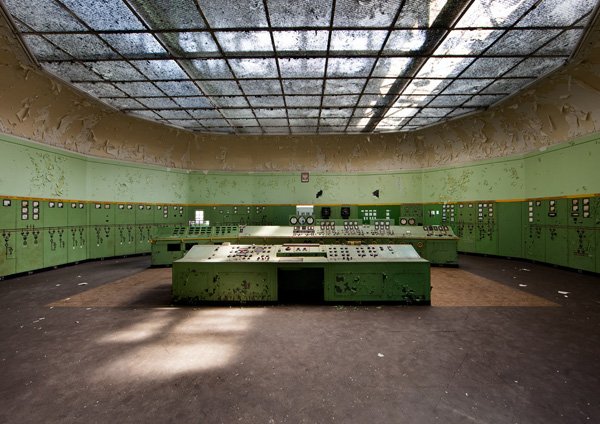
How do you explain the term Heterotopia?
Etymologically, from the Greek « hetero » which means the other and « topos » the place. Heterotopias are the « other places ». It is a concept developed by the philosopher Michel Foucault, whose writing has always fascinated me.
There are places that cannot be found anywhere, places that do not feature on any geographical map, places born in the heads of men. Those places, we call utopia. There are, of course, real spaces in which we live: the streets, cafés, beaches, hotels, homes … Then there are places that stand quite apart from all the others, somewhere between real places and utopian fictions, real places that oppose all others and somehow question the space where we actually live. Those places Foucault called heterotopias.
I invite you to read Foucault’s conference « Des espaces autres, les hétérotopies ». There I found an echo of my subject, I had the impression he spoke of my work and confirmed my ideas. It seems to me that the places I photograph are market out as heterotopias, they are potential heterotopias.
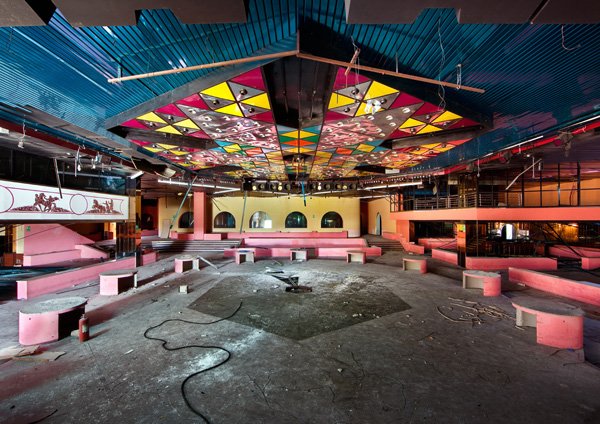
In this text, Foucault enunciates six heterotopic principles. He explains, for example (it is one of the principles) that the heterotopias are linked to a particular outlining of time. In them, time does not go by as in ordinary life; we are not dealing with linear time. He takes the example of libraries and museums where time accumulates. My places show the sedimentation of time. They make the past and the future meet in a temporality that is no longer ascertained by the hours and minutes of clock hands. There time is not linear, it does not go by continuously but stands still, suspended. Those places have lost the thread that links them to their past, like “vessels which have lost their moorings and sail outside any known spatial and time-bound landmarks”. They have exited from History time and contemplate, perhaps with a feeling of mixed tenderness and fright, the uncertain fate of humans that continue to fret around them without realising.
On the other had, the spectator is forced into a temporal to and fro movement. He imagines the building in its youth by a mental reconstitution and construes its final ruin in a movement of imaginary anticipation. We play with time that seems to come close to an illusion. All that is very heterotopic.
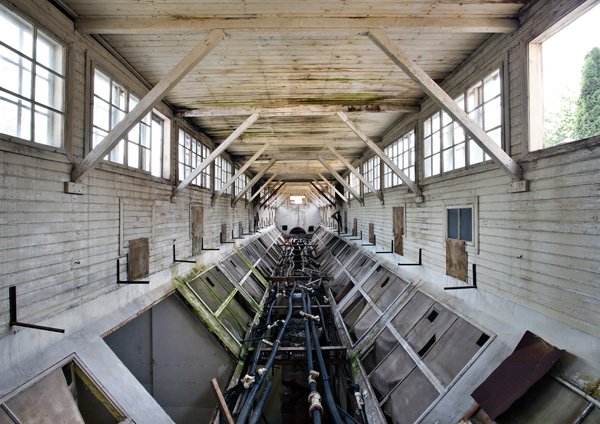
It could be interesting to note at this stage that this principle is reinforced by photography that arrests, immobilises and remains silent. It shows in the now a time that has passed and always presents itself under the guise of a fragment (problem of the off camera field). All those characteristics, photography shares with the building in ruins. We could say of those places that they are ontologically photographical or, perhaps, the opposite, that photography has something of a ruin, certainly in the realm of resistance. In any case, photography seems to me to be the ideal medium for the representation of these places, for it endows them with even more meaning.
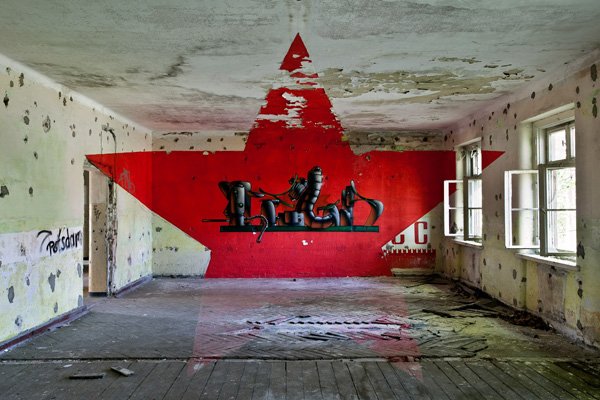
In what geographical or historical perspective does your work belong?
I try to respect a certain universality, and above all, a certain geographical logic. The phenomenon of ruins and dereliction does not belong to geographical issues; no society or civilisation can avoid them. That is why, in a way, there is no spatial or temporal information in my exhibitions. I have found wonderful deactivated industrial places in Norway and Switzerland, countries usually associated with economic prosperity. No nation can pretend to enjoy constant linear progress, the abandonment of certain structures is something that cannot be avoided.
What is important to remember is that these are ruins belong to our time, they have been generated during our historical period. We have little or no distance from this destruction, these manifestations of deterioration. They happen close to us. That lack of distance is at the origin of the polemic character of my work. To be able to enjoy the spectacle of a ruin freely, it is necessary to create some distance from it, to place it far away in space and or in time. By not giving spatial or temporal indications, I reinforce the spectator’s position who, for a moment, thinks he is sheltered, on the shore (therefore, at a distance from), and contemplates the spectacle of these shipwrecks in the comfort of a cosy exhibition room.
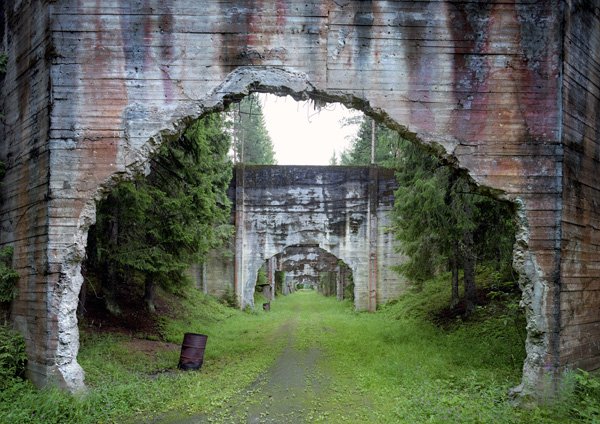
Historically, artists have always been very interested in ruins, but at a certain distance. In some manuscripts dating from the Middle Ages, we find representations of ruins, often motivated by religious themes like the Apocalypse or the Fall of Babylon. These buildings seem intact, as fresh as they were when new. To picture their ruinous state, they are often represented upside down, with the roof below, as in a fall. The “artists” of that time seem incapable of depicting decrepitude; or rather, they do not have any interest in showing the effects of destruction or decadence, for what motivates them is the idea of a ruin and not the degradation of matter itself.
During the Renaissance, we obviously find representations of antique Greek and Roman ruins in the work of numerous painters. We notice in particular that Nativity scenes often take place in a setting of ruins. I would like to suggest that you go and admire such a painting, one that has influenced me in my thinking, by Jean de Gourmont (Nativity attributed to Jean de Gourmont – 1525) in the Louvre museum. I see a certain perfection in it and I try to gear the instruments and the restrictions of the reality that is mine at present in that direction.
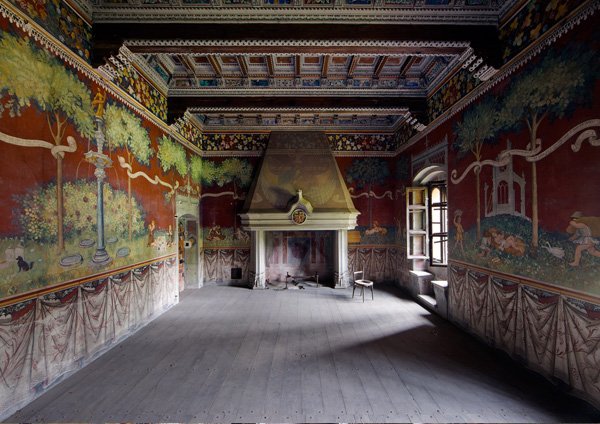
In the XVII century, there was a painter whose work I particularly admire, Monsu Desiderio. His paintings depict the moment when disaster strikes, when building of monumental architecture of antique and biblical inspiration are destroyed. Thanks to this painter, I have understood that my images work in a different way. We ask ourselves what happened and search in the architecture for clues that would allow us to reconstitute the moment of rupture. Smoke and dust have fallen. We are before the consequences, the causes remain mysterious and that leaves a great deal of room for the spectator and for imagination.
In the XVIII century, ruins became a major subject, central to a great number of works and a pictorial theme in itself. I am thinking of Piranese who, in his dramatic engravings, magnifies antiquity and its architecture. I admire his capacity to restore innumerable details in shadowy zones, details featuring in the blackest areas, bathing in shadow; which is in itself a wonderfully critical view of the arrogance of the « Enlightenment ». And then, we must mention Hubert Robert and his anticipated ruins, such as the « Vue imaginaire de la galerie du Louvre en ruines ». The taste for ruins at that time was such that it was taken to the point of ruining buildings (in paintings, in the imagination) and even going as far as building them to adorn gardens (les fabriques).
In the XIX century, the Romantics endowed ruins with a fantastic character. They guessed that there was something in between worlds there, between being and not being, between dream and reality, a state that allowed to explore Nature’s and the human psyche’s unfathomable damaged side. The ruin is thus used as an allegory. Simultaneously, in the same period, with the birth of modern archaeology and photography, there developed a taste for Egyptomania and its ruins.
The XX century was marked by the ruins of war. These are charged with men’s suffering and translated the trauma of war into form. From this period onwards, we began looking with interest at ruins in their contemporaneousness, the distance that separates the spectator from the spectacle diminished. To take pleasure in contemplating a ruin became controversial.
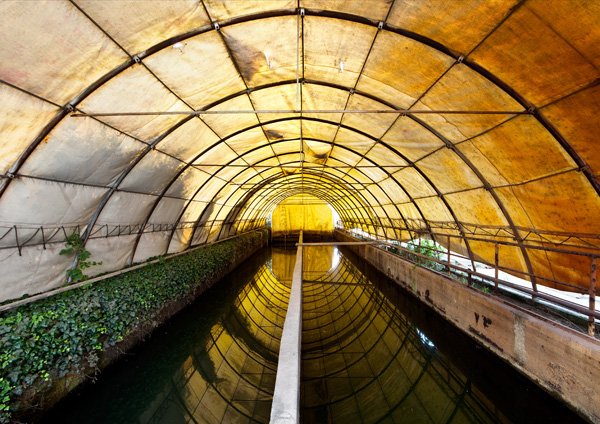
How do you position yourself physically in space? What technical means do you use to obtain those viewpoints?
I always look for a certain height. Unfortunately, I do not have a nacelle like Burtynsky. Instead, I use rudimentary artifices. My tripod can go up to approximately 3 metres, but that is not always sufficient. Then I resort to items I find at the site, such as a table to elevate my tripod. Sometimes, I go to comical lengths to build myself a structure, completely lopsided, with load of stones picked around the demolished structure, for example. Those manufactured aerial views, I take them blindly for I cannot see what I am photographing at all.
So you never use a Fish-eye wide angle lens?
I only use very short focal lenses, 14mm on an APN 24×36 and a 47mm on a Cambo Wide DS 4×5? but they are all « linear » lenses whose deformations remain acceptable in the sense that they give a « natural » aspect to the sites. The fish-eye is not a lens to be discarded, it simply is not adequate for an approach that intends to be objective.
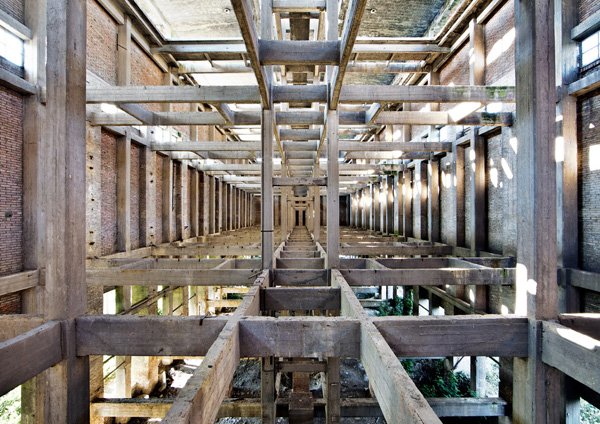
Do you document the geographical zones where you find these ruins?
I am not a photographer that intends to be an archivist, I do not do inventory or itemizing work. To photograph a site, I visit ten sites. There are many more outside the visual fields I select, it is an added difficulty imposed by the rigour of the series. On the other hand, I always carry a GPS that allows me to pinpoint the geographical data of the sites I visit. I keep that information well stored, just in case.
How do you finance all those trips, those long shots?
I used to teach English and photography in an art school in Montreuil. I chose that profession because it allowed me a lot of free time. Today I am trying to present this series and to make a living from that.
Previously, I did a masters degree in Anglo-Saxon languages, literature and civilizations in Paris; my dissertation was on the idea of progress in Victorian painting. Then I taught in England, in Brazil and I travelled a great deal…
To make those long trips, I travel like an adventurer and I sleep in my car adapted to become a mini-van. It is also a question of strategy, because to visit those sites I have to get up very early to be there at the earliest hour. Often, when I go in it is still dark, but that allows me to think out my photo!
How are these photos linked?
I work exclusively in terms of series. When a place does not fit in with this, I do not take the photo. Often I see very beautiful things, quite spectacular or interesting, but I don’t photograph them because it does not make sense, it does not fit into the requirements of a series. The frustration of not being able to photograph them is real, but necessary to maintain a coherent whole.
Then I would say that my work is about the loss of form, without ever going as far as its pure absence, but focusing rather in a tension that is directed to that absence. There are sites that are more or less flat, more or less deconstructed. We go back to the idea of « fall », with the different moments of ruin. That is, partly, what creates the link between the images.
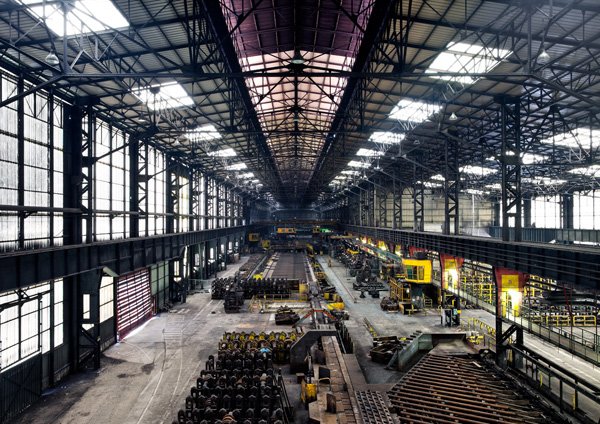
What do you think about the restoration of ruins in general?
We can consider those buildings like forms that have become debilitated and diminished or, on the contrary, places from which life refuses to vanish. Those sites are witnesses to a kind of resistance. They seem to challenge duration, time and the fury of men. For me, they allow me to figure out that invisible tension that animates all things and whose drama is to be unable to avoid obliteration. My images, with a rather theatrical stance, are the scenario of the brave fight that those weakened buildings put up in order not to give in to forgetfulness. I think they must be protected against brutal vandalism and from destruction, but not necessarily from time and its effects. I propose a letting go, a kind of abstentionism that would allow a privileged place that heroic effort. What is wrong with those buildings? Why not accept that ruins are part of our environment? Could they have something to teach us, bang in town centres? First lesson: a warning against utopian projects, the desire for total mastery and perfection. Look at what those monumental projects have become, at what has recently been undertaken in Dubai? The role of those places could be to support a philosophy of humility, the counterpart to some men’s megalomania? My letting go does not mean relegating them to a forgotten corner, it is not about ignoring those spaces. On the contrary, it is about valuing them as ruins, for all to see. That is where, for practical reasons, photography can intervene and play a mediatory role.
On the other hand, I believe that to make room for those buildings would be an effort towards accepting the shadowy parts of our History, of our story, accepting our imperfections and errors. Those places reveal our own limitations, our own vices. The faults are not to be found in the architecture but in the men who built these buildings. One cannot be interested exclusively in the great victorious figures of history, the photographer has to focus also on the vanquished, those who tend to disappear more easily and rapidly. We cannot forget that humanity is also the sum of its errors. Finally, the series’ aim is to attract love to that which is not flattering. I hope that it makes a plea in favour of reconciling man with his weaknesses.
I do not believe restoration is absolutely necessary. It can even be harmful and could, in certain cases, be considered a form of vandalism (terrible because ignored). I would be inclined to agree with the ideas of that Victorian thinker, John Ruskin, for whom restoration is a lie, an attempt to recover and rewrite History.
What is built will decay, there will be losses, voids. Those voids have more meaning and more value than the filling in added by restoration. The void is History, the filling is fiction. Restoration is an illusion, can we awaken the dead? It’s almost like betraying past generations and the memory of places, even losing the comprehension of a historical site. Restoration endangers the testimonial vocations of these places, when those remnants are all they have left. To transform what is authentic into something false is what could be called « Las Vegasising History ».
You are the winner of our photo contest « Photography and its Purpose », what made you want to take part in this competition?
The text I presented regarding photography was written by an author called Pali Malom. Some time ago, I was exhibiting in a small bookshop, she came and was touched. She sent me some prose texts she wrote and some wonderful poems inspired by those images. Therefore, I naturally proposed one of her texts along with one of my photos that I presented for the competition.
What next stages are you planning with Heterotopia? Where would you like to go with this project?
At the beginning, I thought that this work with its systematic outlook would quickly become redundant, but there is such architectural wealth that each of my trips proves worthwhile. I’m thinking of that red nightclub with a hint of cubism. I had not imagined finding such a place. I could not have suspected it existed. I could stop the series at any moment, for there is always something we have yet to come across. But I know that surprise and wonder are still lurking somewhere. Once I find a place which adds to the series, it becomes unavoidable and I wonder how I could have worked without it. Therefore, it seems rather a delicate matter to conclude this series, simply because I believe I can still be surprised.
On the other hand, I intend to carry out this work on « topos ». The series on the theme of ruins is only the first part of my Heterotopia project. I have found another « potential » heterotopic kind of space. What is interesting is that, this time, everything starts on paper. I have written a lot even before taking the first shot. From the beginning, I have been concerned with coherence, a very precise vision of the whole, but I still don’t know how it is going to work visually. If the project loses its poetry, it will fail. As for the photography, I can see it, I know what I want, and I am now going to have to confront reality to see if those kinds of space actually exist.
I don’t want to reveal too much about the second part of Heterotopia. I suggest we meet sometime in the future to discuss it again, around the photographs.
Interview by RD on June 29, 2016
Link to the photographer's website Vincent J. Stoker
